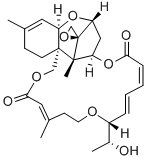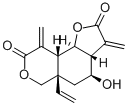1,4-BUTANEDIOL DIACRYLATE
Synonym(s):1,4-Bis(acryloyloxy)butane;1,4-Butanediol diacrylate;Tetramethylene diacrylate
- CAS NO.:1070-70-8
- Empirical Formula: C10H14O4
- Molecular Weight: 198.22
- MDL number: MFCD00014940
- EINECS: 213-979-6
- SAFETY DATA SHEET (SDS)
- Update Date: 2024-12-18 14:15:32

What is 1,4-BUTANEDIOL DIACRYLATE?
Description
A positive patch test was observed in a male process worker in a paint factory, sensitized to an epoxy diacrylate (1,4-butanediol diacrylate) contained in raw materials of UV -light-curable paint. The positive reaction was probably due to a cross reactivity.
Chemical properties
Colorless liquid
The Uses of 1,4-BUTANEDIOL DIACRYLATE
cross-linking monomer for use in inks, adhesives, textile product modifiers, photo resists, etc.
The Uses of 1,4-BUTANEDIOL DIACRYLATE
1,4-Butanediol diacrylate may be used as a multifunctional crosslinker.
The Uses of 1,4-BUTANEDIOL DIACRYLATE
1,4-Butanediol diacrylate is used as a multifunctional crosslinker. It is used in drying technology for paintings, coatings, inks, resins and adhesives. It serves as an intermediate product for polymer synthesis in the chemical industry.
What are the applications of Application
1,4-Butanediol diacrylate is a drying technology for coatings, inks and adhesives
What are the applications of Application
1,4-Butanediol diacrylate is the main material used to make polyurethanes, polyacrylates and polyimides. It is also used to generate polymer nanomaterials and nanocomposites. When heated, BDD polymerises to form stable cross-linked networks by reacting with other molecules, including amines and alcohols, through its acrylate groups. It can also be used to make hydrogels for the study of material properties and interactions. This compound is also useful in the fabrication of electroactive polymer films, whose unique electrical properties are of interest in the field of materials science.
Flammability and Explosibility
Not classified
Properties of 1,4-BUTANEDIOL DIACRYLATE
| Melting point: | -7°C |
| Boiling point: | 83 °C/0.3 mmHg (lit.) |
| Density | 1.051 g/mL at 25 °C (lit.) |
| vapor pressure | 0.83 hPa (80 °C) |
| refractive index | n |
| Flash point: | >230 °F |
| storage temp. | 2-8°C |
| solubility | 16.3g/l |
| form | Liquid |
| Specific Gravity | 1.055-1.105 |
| color | Colorless |
| explosive limit | 1.3-7%(V) |
| Water Solubility | Immiscible with water. |
| CAS DataBase Reference | 1070-70-8(CAS DataBase Reference) |
| EPA Substance Registry System | 1,4-Butanediol diacrylate (1070-70-8) |
Safety information for 1,4-BUTANEDIOL DIACRYLATE
| Signal word | Danger |
| Pictogram(s) |
 Corrosion Corrosives GHS05  Skull and Crossbones Acute Toxicity GHS06 |
| GHS Hazard Statements |
H311:Acute toxicity,dermal H314:Skin corrosion/irritation H317:Sensitisation, Skin H412:Hazardous to the aquatic environment, long-term hazard |
| Precautionary Statement Codes |
P273:Avoid release to the environment. P280:Wear protective gloves/protective clothing/eye protection/face protection. P301+P312:IF SWALLOWED: call a POISON CENTER or doctor/physician IF you feel unwell. P303+P361+P353:IF ON SKIN (or hair): Remove/Take off Immediately all contaminated clothing. Rinse SKIN with water/shower. P305+P351+P338:IF IN EYES: Rinse cautiously with water for several minutes. Remove contact lenses, if present and easy to do. Continuerinsing. |
Computed Descriptors for 1,4-BUTANEDIOL DIACRYLATE
New Products
Tert-butyl bis(2-chloroethyl)carbamate (S)-3-Aminobutanenitrile hydrochloride N-Boc-D-alaninol N-BOC-D/L-ALANINOL N-octanoyl benzotriazole 4-Hydrazinobenzoic acid 3,4-Dibenzyloxybenzaldehyde 1,1’-CARBONYLDIIMIDAZOLE R-2-BENZYLOXY PROPIONIC ACID 1,1’-CARBONYLDI (1,2-4 TRIAZOLE) 4-HYDROXY BENZYL ALCOHOL 3-NITRO-2-METHYL ANILINE (2-Hydroxyphenyl)acetonitrile 4-Bromopyrazole 5-BROMO-2CYANO PYRIDINE 5,6-Dimethoxyindanone 5-broMo-2-chloro-N-cyclopentylpyriMidin-4-aMine 4-methoxy-3,5-dinitropyridine 2-(Cyanocyclohexyl)acetic acid 2-aminopropyl benzoate hydrochloride 1-(4-(aminomethyl)benzyl)urea hydrochloride tert-butyl 4- (ureidomethyl)benzylcarbamate diethyl 2-(2-((tertbutoxycarbonyl)amino) ethyl)malonate Ethyl-2-chloro((4-methoxyphenyl)hydrazono)acetateRelated products of tetrahydrofuran






![3,4A,4B,6-TETRAMETHYL-4A,4B,8A,8B-TETRAHYDROPYRANO[3',2':3,4]CYCLOBUTA[1,2-B]PYRAN-2,7-DIONE](https://img.chemicalbook.in/StructureFile/ChemBookStructure6/GIF/CB8301156.gif)

You may like
-
 1,4-Butanediol diacrylate, Stabilized with 50 to 105 ppm hydroquinone CAS 1070-70-8View Details
1,4-Butanediol diacrylate, Stabilized with 50 to 105 ppm hydroquinone CAS 1070-70-8View Details
1070-70-8 -
 1,4-Butanediol diacrylate, 90% CAS 1070-70-8View Details
1,4-Butanediol diacrylate, 90% CAS 1070-70-8View Details
1070-70-8 -
 1,4-Bis(acryloyloxy)butane (stabilized with MEHQ) CAS 1070-70-8View Details
1,4-Bis(acryloyloxy)butane (stabilized with MEHQ) CAS 1070-70-8View Details
1070-70-8 -
 1,4-Butanediol diacrylate CAS 1070-70-8View Details
1,4-Butanediol diacrylate CAS 1070-70-8View Details
1070-70-8 -
 N-Vinylformamide 99%View Details
N-Vinylformamide 99%View Details
13162-05-5 -
 Chloro Uracil 1820-81-1 99%View Details
Chloro Uracil 1820-81-1 99%View Details
1820-81-1 -
 2-ethyl-6-methyl-3-hydroxypyridine succinate 99%View Details
2-ethyl-6-methyl-3-hydroxypyridine succinate 99%View Details
127464-43-1 -
 2-ETHYLPYRIDINE 100-71-0 99%View Details
2-ETHYLPYRIDINE 100-71-0 99%View Details
100-71-0